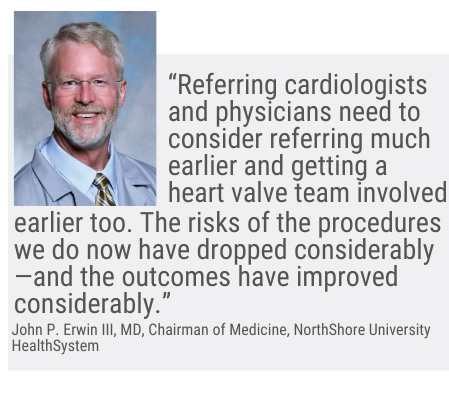Q&A U.S. and European Valvular Heart Disease Guidelines: Lessons from Across the Pond
“Good harmony” is the way John P. Erwin III, MD, describes the synergy of the 2021 ESC/EACTS Guidelines for the management of valvular heart disease (VHD) released in August along with the ACC/AHA guidelines that rolled in December 2020. A member of the ACC/AHA writing committee since 2014, the chairman of medicine at NorthShore University HealthSystem and a clinical professor at the University of Chicago Pritzker School of Medicine says that continuity was well planned.
The European guidelines focus on decision-making in VHD with an emphasis on “accurate diagnosis, timing of intervention and risk assessment, and, based on these, selection of the most suitable type of intervention.” The objective is VHD patient management. The guidelines also offer guidance on symptomatic aortic stenosis (AS) patients and more evidence and insight on patients 65-80 and people over 80 for whom transfemoral transcatheter aortic valve replacement (TAVR) is now a CLASS 1A recommendation.
As Erwin told Cardiovascular Business on a recent afternoon, guidelines are now “living” entities, nimble and able to change as evidence evolves to benefit patients and care teams. They’re also more easily imbedded in EMR decision-making trees. He offers great insight on how the guidelines are similar, how they differ and how heart teams should combine the wisdom of each to advise decision-making and interventions.

How do you view the 2021 ESC/EACTS guidelines vs. the 2020 ACC/AHA guidelines?
There's really good harmony between them. That's not out of happenstance. We reached out across the pond to make sure we're keeping on the same page because the world's gotten a lot smaller. If we give mixed messages as to what our guidance is, it can be really confusing to the clinician trying to use these tools. It's not lockstep, it's not verbatim, but the general principles and most of the specific guidance are very similar.
There are only minor differences amongst the guidelines, mostly due to a couple of trials being completed in the timeframe in between. Thus, [the ESC] upgraded the level of evidence in a couple of the recommendations.
The process of guideline writing isn't arbitrary and capricious. We’ve taken painstaking approaches, especially through the ACC/AHA, to start with the data and work backward from that to our guidance. We've worked hard with ACC/AHA for the last several iterations of guidelines to ensure that we're minimalizing those recommendations that we make purely by “expert consensus.” We're letting the data guide us. And thankfully in cardiology, we have a lot of data.
Our evidence-based approach has been very strong over the years and our European colleagues are the same way. So, when both societies complete our guideline sets, we send it out for public commentary across multiple specialty societies within cardiology. We also invite lay members and governmental policymakers to weigh in. The authors go back and make sure we're being true to all the evidence.
If you want to dig into the guidelines
To See What's New
What studies were pivotal between 2020 and 2021?
One of the first points that changed was the recommendation that there'd be surgical excision to external clipping of the left atrial appendage in patients undergoing valve surgery. That’s on the basis of the LAAOS III (left atrial appendage occlusion) trial that was published in between the release of the guidelines. [ESC/EACTS] moved what in our 2020 guideline was a 2B recommendation to a 2A recommendation. The trial showed the advantage of when we’re doing valvular work, we should go ahead and exclude that left atrial appendage. That's for people who had a CHA₂DS₂-VASc score for atrial fibrillation stroke risk of two or greater. The recommendation in both guidelines is a class I for people who are in atrial fibrillation.
We'll probably be upgrading the American College of Cardiology guidelines to those same approaches. One of the nice things that Drs. [Katherine] Otto and [Rick] Nishimura, who chaired our committee, had been working on over our last three permutations is the ability to make changes to the guidelines in a modular fashion. For instance, with the ACC/AHA guidelines app, we can go in and make plug-and-play changes as long as everybody is in agreement, as the evidence changes. It is a continually updating entity, a living document.
What about patient age and risk score?
The European guidelines put a bit more emphasis on the aortic stenosis intervention based on age and risk. In the U.S. age was more of a focus with SAVR and TAVI being equally considered as an option from 65-80 years old ― and then TAVI recommended for 80 and older. Whereas in European guidelines, TAVI is recommended starting at age 75. U.S. guidelines are evidence-based in the sense that the Society of Thoracic Surgeons (STS) database tells us what the risk is to a particular patient. We know risk escalates quite significantly once a person is age 75 and above. So, it's not trial-based necessarily, but these are large outcome registries of surgery or TAVI over many years.
What about changes in medications in the European guidelines?
There is a more enhanced preference of novel oral anticoagulant medications over vitamin K antagonists for multiple indications. If we look back at some of the previous permutations of all of our guidelines, basically valvular heart disease was all lumped together and if you had “valvular heart disease,” you shouldn't use a novel oral anticoagulant. You should use a vitamin K antagonist. That’s no longer the case.
Both guidances put a lot more emphasis in sorting through where that evidence is. The only two places where a vitamin K antagonist is considered to be class I, and the only option, is in someone with a prosthetic valve or rheumatic mitral stenosis. Those are the instances where vitamin K antagonist have clearly shown superiority. In the past, it was all lumped together. We now emphasize that there are more indications for novel oral anticoagulants in valvular heart disease, outside of prosthetic and outside of a rheumatic mitral valve disease.
What are the key takeaways for referring cardiologists?
The biggest takeaway is to consider referring patients earlier. The entire equation that we've worked with over the entire history of cardiology has been that surgery and percutaneous interventions are very dangerous and the outcomes may not be perfect in those scenarios. So many times in the past physicians would wait until someone was extremely sick.
Referring cardiologists and physicians need to consider referring much earlier and getting a heart valve team involved earlier too. The risks of the procedures we do now have dropped considerably—and the outcomes have improved considerably. We know there's a trade-off. We want the patient to be as healthy as possible. So the better shape we can get that person in, to meet the structural heart team, the better we hope the outcome is going to be.
What impact do you see this having on physicians and patients moving forward?
The key is it's getting easier to get and use this information. There are so many trials coming out all that time that it's almost impossible to keep up. Guidelines offer a one-stop shop to stay up to date. The guideline apps are very easy, you just pull them up on your phone. While I’m sitting with a patient, I can take a look at the recommendation for that particular scenario. They’re well laid out algorithms that simplify things a lot. With these apps, they can be embedded into electronic health records. I think the next step will be embedding artificial intelligence decision assistance. That said, we’re still going to require a human brain to decide what's best and to do shared decision-making with the patient.
Over the history of medicine, there've been so many errors of omission just because we didn't have all of our information together. Embedding some of these guidelines into our decision trees, we're going to decrease the likelihood that somebody gets missed. Early detection and treatment are the goal.
2020 ACC/AHA Guidelines: Top 10 Take-Home Messages
- Disease stages in patients with valvular heart disease should be classified (Stages A, B, C, and D) on the basis of symptoms, valve anatomy, the severity of valve dysfunction, and the response of the ventricle and pulmonary circulation.
- In the evaluation of a patient with valvular heart disease, history and physical examination findings should be correlated with the results of noninvasive testing (ie, ECG, chest x-ray, transthoracic echocardiogram). If there is discordance between the physical examination and initial noninvasive testing, consider further noninvasive (computed tomography, cardiac magnetic resonance imaging, stress testing) or invasive (transesophageal echocardiography, cardiac catheterization) testing to determine optimal treatment strategy.
- For patients with valvular heart disease and atrial fibrillation (except for patients with rheumatic mitral stenosis or a mechanical prosthesis), the decision to use oral anticoagulation to prevent thromboembolic events, with either a vitamin K antagonist or a non–vitamin K antagonist anticoagulant, should be made in a shared decision-making process based on the CHA2DS2-VASc score. Patients with rheumatic mitral stenosis or a mechanical prosthesis and atrial fibrillation should receive oral anticoagulation with a vitamin K antagonist.
- All patients with severe valvular heart disease being considered for valve intervention should be evaluated by a multidisciplinary team, with either referral to or consultation with a Primary or Comprehensive Valve Center.
- Treatment of severe aortic stenosis with either a transcatheter or surgical valve prosthesis should be based primarily on symptoms or reduced ventricular systolic function. Earlier intervention may be considered if indicated by results of exercise testing, biomarkers, rapid progression, or the presence of very severe stenosis.
- Indications for transcatheter aortic valve implantation are expanding as a result of multiple randomized trials of transcatheter aortic valve implantation versus surgical aortic valve replacement. The choice of type of intervention for a patient with severe aortic stenosis should be a shared decision-making process that considers the lifetime risks and benefits associated with type of valve (mechanical versus bioprosthetic) and type of approach (transcatheter versus surgical).
- Indications for intervention for valvular regurgitation are relief of symptoms and prevention of the irreversible long-term consequences of left ventricular volume overload. Thresholds for intervention now are lower than they were previously because of more durable treatment options and lower procedural risks.
- A mitral transcatheter edge-to-edge repair is of benefit to patients with severely symptomatic primary mitral regurgitation who are at high or prohibitive risk for surgery, as well as to a select subset of patients with secondary mitral regurgitation who remain severely symptomatic despite guideline-directed management and therapy for heart failure.
- Patients presenting with severe symptomatic isolated tricuspid regurgitation, commonly associated with device leads and atrial fibrillation, may benefit from surgical intervention to reduce symptoms and recurrent hospitalizations if done before the onset of severe right ventricular dysfunction or end-organ damage to the liver and kidney.
- Bioprosthetic valve dysfunction may occur because of either degeneration of the valve leaflets or valve thrombosis. Catheter-based treatment for prosthetic valve dysfunction is reasonable in selected patients for bioprosthetic leaflet degeneration or paravalvular leak in the absence of active infection.

